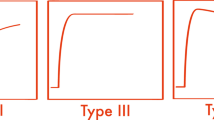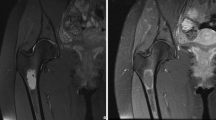Abstract
Objective
The aim of this work was to determine the role of MRI in interpreting abnormal signals within bones and soft tissues adjacent to tumor bulk of osteosarcoma and Ewing’s sarcoma in a pediatric population by correlating MR findings with histopathology.
Materials and methods
Thirty patients met the inclusion criteria, which included (1) osteosarcoma or Ewing’s sarcoma, (2) MR studies no more than 2 months prior to surgery, (3) presence of abnormal MR signal surrounding the tumor bulk, (4) pathological material from resected tumor. The patients received standard neoadjuvant chemotherapy. Using grid maps on gross pathology specimens, the abnormal MR areas around the tumor were matched with the corresponding grid sections. Histopathology slides of these sections were then analyzed to determine the nature of the regions of interest. The MR/pathological correlation was evaluated using Mann–Whitney U test and Fisher’s exact test.
Results
Twenty-seven patients had osteosarcoma and three patients had Ewing’s sarcoma. Of the studied areas, 17.4% were positive for tumor (viable or necrotic). There was no statistically significant correlation between areas positive for tumor and age, gender, signal extent and intensity on MRI, or tissue type. There was, however, a statistically significant correlation between presence of tumor and the appearance of abnormal soft tissue signals. A feathery appearance correlated with tumor-negative areas whereas a bulky appearance correlated with tumor-positive regions.
Conclusions
MR imaging is helpful in identifying the nature of abnormal signal areas surrounding bone sarcomas that are more likely to be tumor-free, particularly when the signal in the soft tissues surrounding the tumor is feathery and edema-like in appearance.






Similar content being viewed by others
References
Herzog CE. Overview of sarcomas in the adolescent and young adult population. J Pediatr Hematol Oncol. 2005;27(4):215–8.
Caudill JS, Arndt CA. Diagnosis and management of bone malignancy in adolescence. Adolesc Med State Art Rev. 2007;18(1):62–78. ix.
Longhi A, Errani C, De Paolis M, et al. Primary bone osteosarcoma in the pediatric age: state of the art. Cancer Treat Rev. 2006;32:423–36.
Seeger LL, Widoff BE, Bassett LW, et al. Preoperative evaluation of osteosarcoma: Value of gadopentate dimeglumine-enhanced MR imaging. AJR. 1991;157:347–51.
Onikul E, Fletcher BD, Parham DM, et al. Accuracy of MR imaging for estimating intraosseous extent of osteosarcoma. AJR. 1996;167:1211–5.
Sundaram M, McGuire MH, Herbold DR, Wolverson MK, Heiberg E, et al. Magnetic resonance imaging in planning limb-salvage surgery for primary malignant tumors of bone. J Bone Joint Surg Am. 1986;68:809–19.
Brisse H, Ollivier L, Edeline V, et al. Imaging of malignant tumours of the long bones in children: monitoring response to neoadjuvant chemotherapy and preoperative assessment. Pediatr Radiol. 2004;34:595–605.
Kaste SC. Imaging pediatric bone sarcomas. Radiol Clin North Am. 2011;49(4):749–65. vi-vii.
Panuel M, Gentet JC, Scheiner C, et al. Physeal and epiphyseal extent of primary malignant bone tumors in childhood. Correlation of preoperative MRI and the pathologic examination. Pediatr Radiol. 1993;23(6):421–4.
Schima W, Amann G, Stiglbauer R, et al. Preoperative staging of osteosarcoma: efficacy of MR imaging in detecting joint involvement. Am J Roentgenol. 1994;163(5):1171–5.
Hoffer FA, Nikanorov AY, Reddick WE, et al. Accuracy of MR imaging for detecting epiphyseal extension of osteosarcoma. Pediatr Radiol. 2000;30:289–98.
Erlemann R, Reiser MF, Peters PE, et al. Musculoskeletal neoplasms: static and dynamic Gd-DTPA-enhanced MR imaging. Radiology. 1989;171(3):767–73.
Sanchez RB, Quinn SF, Walling A, et al. Musculoskeletal neoplasms after intraarterial chemotherapy: correlation of MR images with pathologic specimens. Radiology. 1990;174(1):237–40.
Lang P, Honda G, Roberts T, et al. Musculoskeletal neoplasm: perineoplastic edema versus tumor on dynamic postcontrast MR images with spatial mapping of instantaneous enhancement rates. Radiology. 1995;197(3):831–9. Erratum in: Radiology 1996;198(3):910–911.
Beltran J, Simon DC, Katz W, et al. Increased MR signal intensity in skeletal muscle adjacent to malignant tumors: pathologic correlation and clinical relevance. Radiology. 1987;162(1 Pt 1):251–5.
Shuman WP, Patten RM, Baron RL, et al. Comparison of STIR and spin-echo MR imaging at 1.5 T in 45 suspected extremity tumors: lesion conspicuity and extent. Radiology. 1991;179(1):247–52.
White LM, Wunder JS, Bell RS, et al. Histologic assessment of peritumoral edema in soft tissue sarcoma. Int J Radiat Oncol Biol Phys. 2005;61(5):1439–45.
Lawrence JA, Babyn PS, Chan HS, et al. Extremity osteosarcoma in childhood: prognostic value of radiologic imaging. Radiology. 1993;189:43–7.
McDonald DJ. Limb-salvage surgery for treatment of sarcomas of the extremities. AJR. 1994;163(3):509–13.
James SL, Panicek DM, Davies AM. Bone marrow oedema associated with benign and malignant bone tumours. Eur J Radiol. 2008;67(1):11–21.
Acknowledgements
The authors would like to thank The Board of Trustees of the Children’s Cancer Center of Lebanon Foundation and the International Outreach Program at the St. Jude Children’s Research Hospital, Memphis, TN, USA, for their continuous support. The authors would also like to thank Dr. Monique Chaaya (Chair, Department of Epidemiology & Population Health, American University of Beirut, Beirut, Lebanon) for her assistance in statistical analysis.
Author information
Authors and Affiliations
Corresponding author
Rights and permissions
About this article
Cite this article
Masrouha, K.Z., Musallam, K.M., Samra, A.B. et al. Correlation of non-mass-like abnormal MR signal intensity with pathological findings surrounding pediatric osteosarcoma and Ewing’s sarcoma. Skeletal Radiol 41, 1453–1461 (2012). https://doi.org/10.1007/s00256-012-1383-8
Received:
Revised:
Accepted:
Published:
Issue Date:
DOI: https://doi.org/10.1007/s00256-012-1383-8




